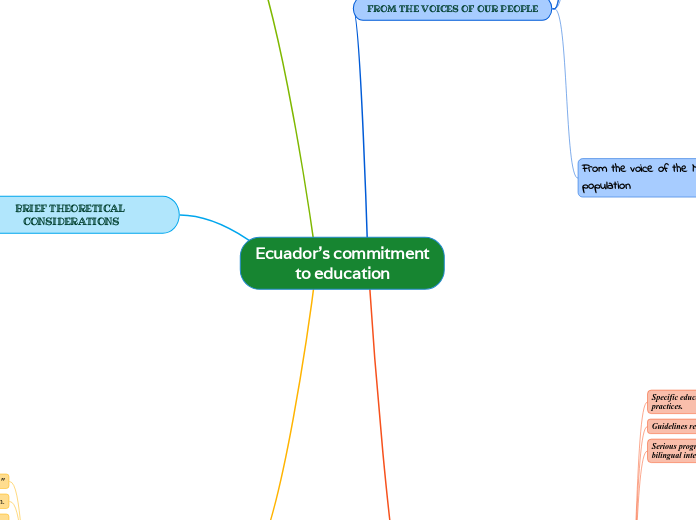Ecuador’s commitment to education
FOREIGN LANGUAGES, LINGUISTIC AND EDUCATIONAL POLICIES
FL for teachers
Until 1986.
The bilingual intercultural educational system started in 1993 through the IPIB.
Teacher training colleges, learning of a foreign language.
Access to indigenous schools is not always easy.
Linguistic and methodological aspects.
FL for students
Until 1992.
Students firm basis in the handling of English, and thus offer them a starting point for their future.
Four skills: listening, speaking, reading, and writing.
BRIEF THEORETICAL CONSIDERATIONS
Bilingualism, diglossia and minoritized bilingualism
Linguistic-educational policies.
Bilingualism implies the knowledge of two or more languages, and can both describe an individual or a group situation.
Teaching-learning
of mother tongues.
The official language, speak an indigenous one –for example Kichwa-shall be considered as minoritized bilinguals.
Social
inequalities.
Dynamic processes modeled by social
conflicts,
Ethnic and socio-linguistic conflicts.
Ecuadorian situation in
general.
Stereotypes and attitudes which.
Meanwhile, diglossia.
Practice.
Linguistic Attitude
"Languages for specific purposes."
Acquisition of the language.
Maintenance or loss.
Attitudes, concrete functions assigned to a
language.
Readiness to react favorably or unfavorably against a
type of objects based on one´s beliefs, experiences.
Social and psychological prejudices.
Complex and multidimensional.
Therefore, difficult to analyze.
Multilingual contexts.
Extra-linguistic needs.
Tangible functions of
a language.
AN ONGOING EXPERIENCE: THE CHILDREN AND FAMILY CENTER
"Children and Family Center."
Rural area neighboring Quito.
Pre-school, primary, and secondary education.
Employment opportunities
Traditions, history and collective art of the people related to the school.
Kichwa was taught and sporadically some foreign language.
Teaching of English and another Ecuadorian
indigenous language
Needs of the students and the
presence of tutors.
Foreign volunteers and students who have
come to the country as part of academic agreements.
FROM THE VOICES OF OUR PEOPLE
"Indians and Mestizos."
"Making justice."
Teaching-learning of a foreign language.
Professionals and university students in Quito.
Betwen October and November 1997
Indian leaders and school students from several indigenous communities in the Ecuadorian Highlands.
Several opportunities
Between 1992 & 1997 and in the
summer of 2006.
The voice of the indigenous population
Great interest for the use of English has appeared in
Ecuador.
Indigenous groups dedicated to trade and commerce.
The increase of tourism.
"Sinchi Sacha Foundation."
Ethno-linguistic attitudes.
Bilingual Kichwa-Spanish schools.
Better job opportunities, national and the international levels.
Technology and modernism.
Self-managed projects.
"Mestizo population."
From the voice of the Mestizo population
Viewpoint and disposition.
Implementation of the teaching of foreign languages in minoritized groups in the country.
Underline the universe
sampled.
The field of language teaching.
Maintain local identities
and languages.
Cultural and linguistic conflicts.
Dynamic and creative entity.
Not forget ethnicity
needs.
Intercultural bilingual
system.
New languages and pedagogical trends.
Overcoming ethnic.
Homogenization.
The intercultural bilingual educational system: National Directorate of Intercultural Bilingual Education (DINEIB).
In 2005.
The establishment of curriculum.
Appropriate contents for the teaching of such language in multilingual contexts.
Is taught and there is curriculum designed for the effect.
Needs of our indigenous population.
Demand quality education.
Positive outcomes.
Implementation of programs.
“Tough accomplishing something like this in rural
areas."
Rural and indigenous schools have incurred on their own in foreign language teaching experiences.
Indians confined to their communities, or a real linguistic, educational and social empowerment.
FOREIGN LANGUAGES FOR THE MINORITIZED?
Specific educational policies and
practices.
Guidelines related to basic educational parameters.
Serious program of foreign language teaching in bilingual intercultural schools.
Methodology
Functional aspects of the language.
Teaching-learning techniques.
Learning process.
Develop creativity.
Freedom of expression.
Group work.
Motivation towards discovery.
Educational-pedagogic techniques.
Principles of interculturality.
Follow-up versus evaluation
Altering the pedagogic
project.
Framework of mutual respect.
Follow up on the achievements.
Individual portfolios.
Participation of the family and the community.
Emphasize each student’s individual progress.
Being an authority and
becomes part of a “team.”
Students are motivated to “build”, write, draw, mold a personal journal.
Different cultural
contexts.
Have proven that follow-up.
Built in this way.
Eliminates competitiveness and
promotes group work and respect towards the other.
